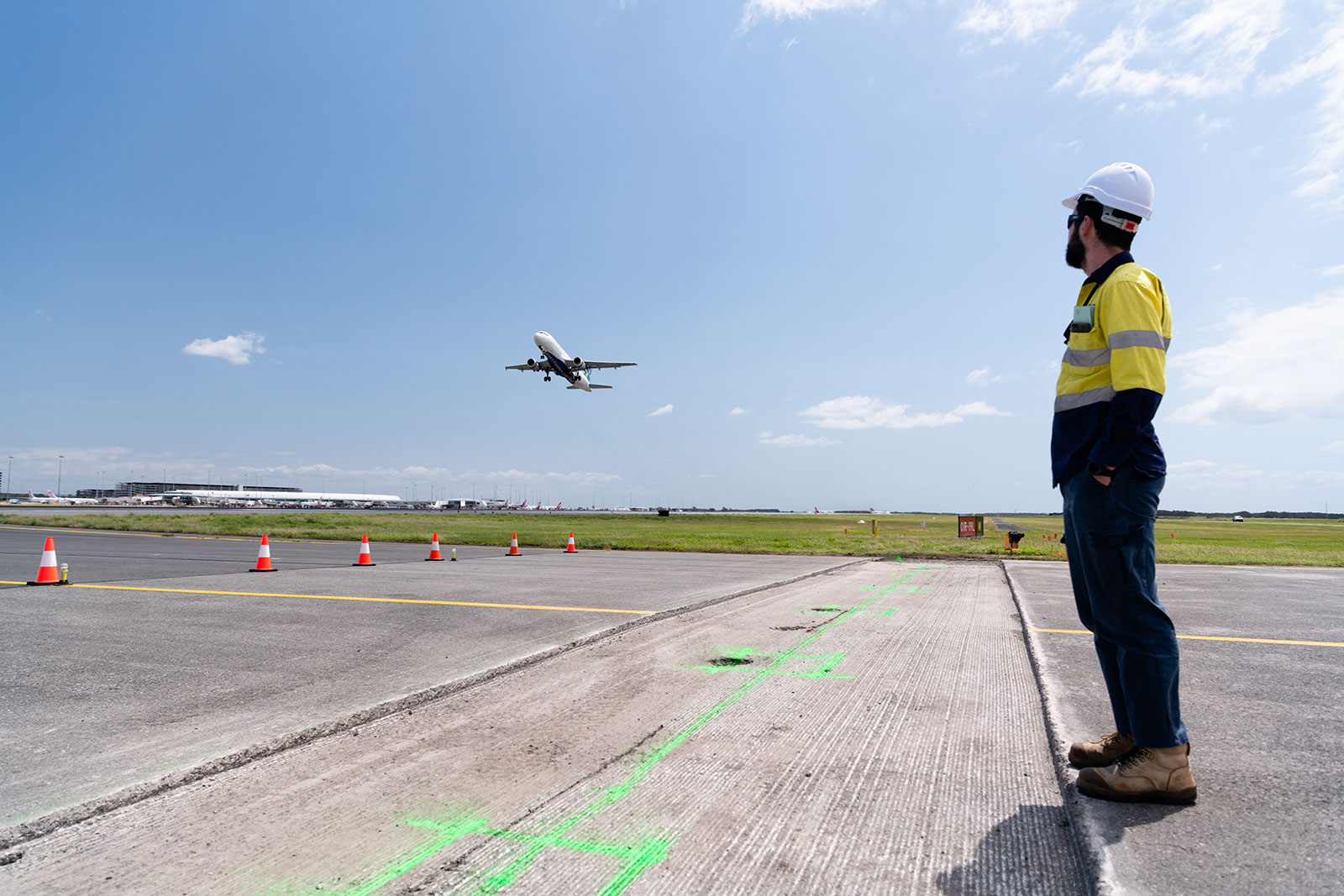
Stop Bars. They sound like an edgy franchise renowned for beer and tapas, but they have nothing to do with liquor and snacks.
So, what are Stop Bars and why have they been introduced to Brisbane Airport?
What are Stop Bars?
Like Gandalf to the Balrog on the bridge of Khazad-dum, Stop Bars prevent aircraft and vehicles from passing taxiway holding points onto an active runway.
They are the traffic lights of the airfield – an extra safety measure designed to mitigate the risk of runway incursions and optimise runway efficiency during low visibility operations like heavy rain or the odd fog event.
Stop Bars are a line of unidirectional lights located 0.3 metres before each runway holding point, embedded into the surface and spaced three metres apart across the full width of the taxiway.
Embracing the universal colour of danger, they show red in the direction of approach to the runway and clearly indicate to pilots and drivers when and where to stop prior to entering a runway.
They are in operation 24 hours a day, seven days a week, and they are controlled by Air Traffic Control (ATC).
A vehicle or aircraft cannot pass a Stop Bar while it is illuminated. They can only move past the holding point once ATC provides the appropriate verbal instruction AND the red lights have been switched off.
The Stop Bar lights are interlocked with green ‘lead-on’ lights that illuminate only when the red lights are switched off. This means that under normal operations, when the Stop Bars are extinguished, the green lights will illuminate the taxiway pathway ahead onto the runway.
Why have they been introduced to Brisbane Airport?
Runway incursions are an ongoing safety concern, with approximately 15-20 occurring in Australia every month. What is a Runway incursion? It is the occurrence at an aerodrome involving the incorrect presence of an aircraft, vehicle or person on the protected area of a surface designated for the landing and take-off of aircraft.
Brisbane Airport will have 24 Stop Bars in total – 10 across the existing runway and 14 across the new runway.
Today, the 10 Stop Bars across the existing runway have been switched on. They will complement existing yellow Runway Guard Lights, MAG signs and Runway Holding Point markings to enhance visibility of holding points, reinforce control of aircraft and vehicles in the vicinity of holding points, and increase the defence against user error and misidentification.
As the operator of Brisbane Airport, Brisbane Airport Corporation (BAC) places the utmost importance on safety across all facets of the airport environment. The reason is pretty simple. Without safe operations, we would lose the public’s trust, our reputation, and our licence to operate.
Through our business strategy, BAC is driven by four strategic goals, one of which is supercharging efficiency.
While Stop Bars are not a particularly new or innovative technology, the function they provide directly aligns with these values and goals, and the way in which it has been introduced at Brisbane Airport is well worth celebrating.
The opportunity to incorporate Stop Bars within Brisbane Airport arose the moment the design for Brisbane’s new runway was finalised. As Brisbane’s new runway (01L-19R) is designed to include Stop Bars, the existing runway (01R-19L) would also need to include Stop Bars.
How were they installed?
Extensive work has been done over the last 12 months to install Stop Bars to the existing runway, with several BAC teams working closely together to ensure the project was undertaken with minimal operational impacts.
Throughout this process, BAC has sought to understand the successes and failures of other airports across that have introduced Stop Bars in order to deliver the best possible outcome for Brisbane Airport.
GHD designed the Stop Bars, with the New Parallel Runway (NPR) team and the Airport Lighting team heavily involved in the design development process. They were also essential in understanding issues encountered at other airports and implementing design solutions to overcome these issues.
Throughout 2019, more than 500 new lights were installed and connected back to airfield lighting and equipment rooms via five kilometres of new underground conduits. The Airport Lighting team provided electrical isolations as required to allow Skyway and ADB Safegate to proceed with construction.
It is worth remembering that Brisbane Airport operates 24 hours a day, seven days a week, 365 days year. The challenge of installing Stop Bars to the existing runway system was significant considering it was an active airfield, so a large majority of the work was completed at night when aircraft volumes were at their lowest.
The teams also maximised the opportunity presented during scheduled heavy maintenance work periods. On one weekend every six months, the runway is closed from midnight to 5am. During these periods, as many as 100 airfield lighting specialists were brought in from across the country to work on the project.
BAC’s Operations team facilitated access to perform the work, which is no mean feat. This process involved coordinating with key stakeholders (ATC as well as airlines and industry partners), escorting convoys of up to 20 construction work vehicles, and organising numerous displaced thresholds to allow uninterrupted construction at A1/A9 (the taxiways on the far ends of the runway).
Without the collaboration and hard work of Skyway, ADB Safegate, Airservices Australia, and BAC’s NPR, Operations and Airport Lighting teams, this project would not have been the success that it is.



